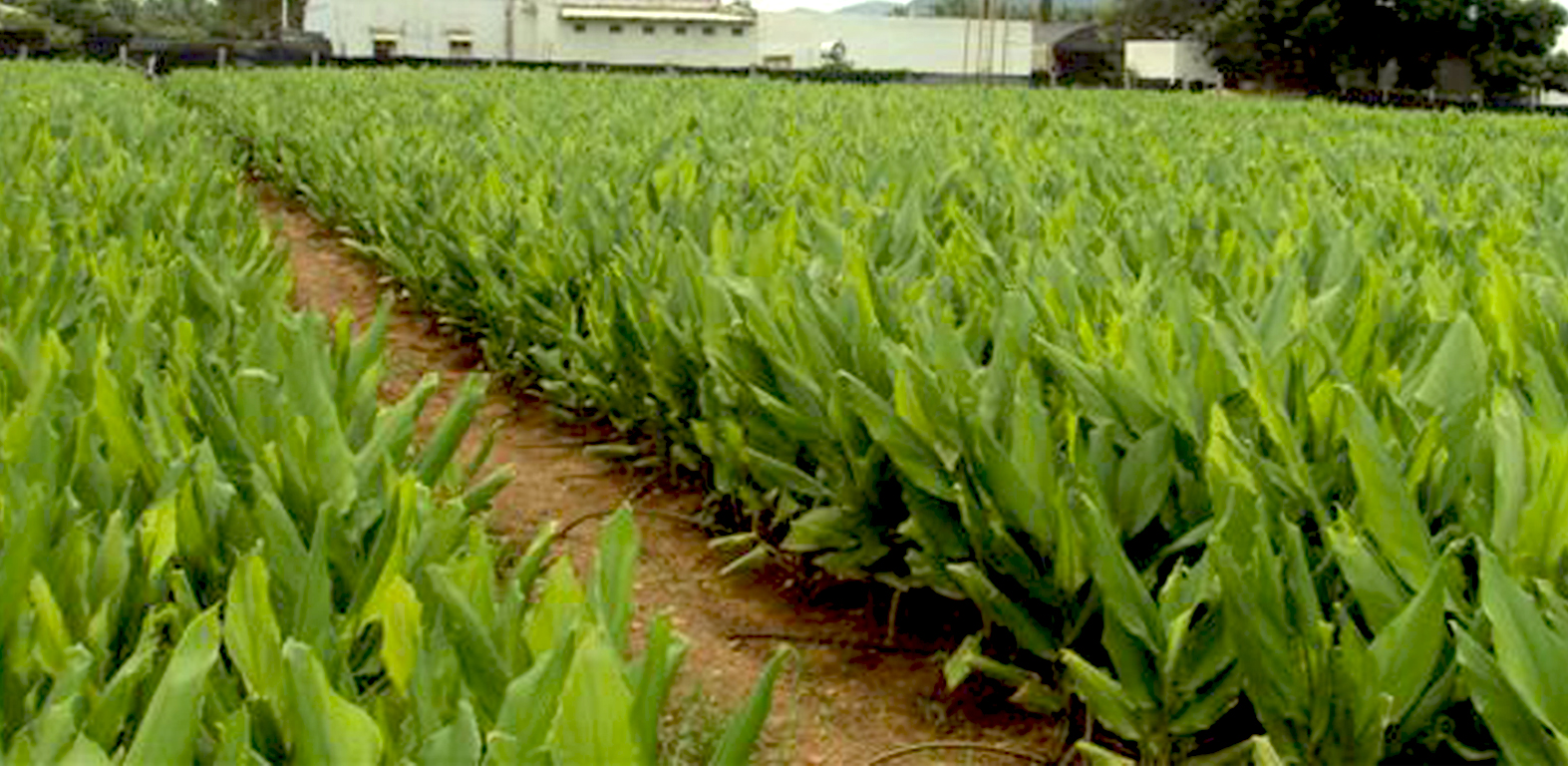Welcome to Jain Irrigation Systems Ltd.

Blog at Jains - HOW MUCH WATER DOES MY CROP NEED? Part 9. Turmeric
Turmeric, (Curcuma longa) is a spice. It is commonly used in Asian Cuisine. It has a warm, bitter taste and is frequently used to flavour and colour curry powders, mustards, butters, and cheeses. The rhizome is also used widely in medicine and cosmetics. It contains a yellow-coloured chemical called curcumin. The economic part of the plant is the underground rhizomes which develop fingers and contain curcumin (8-10%) for which it is valued in commerce.
Turmeric is commonly used for conditions involving pain and inflammation, such as osteoarthritis. It is also used for hay fever, depression, high cholesterol, a type of liver disease, and itching. Some people use turmeric for heartburn, thinking and memory skills, inflammatory bowel disease, stress, and many other conditions.
Turmeric is grown as an annual in tropical and subtropical regions of India. It can be grown from sea level to 1500 m in the hills, at a temperature range of 20-300C with a rainfall of 1500-2250mm per annum. It is also grown as an irrigated crop in many states of India.
It thrives best in a well-drained sandy or clayey loam rich in humus content. It can be grown on different soil viz. light black, ashy loam and red soils to clay loams.
India is the largest producer, consumer and exporter of turmeric in the world. Indian turmeric is considered to be the best in the world market because of its high curcumin content. India accounts for about 80 per cent of world turmeric production and 60 per cent of world exports. Major turmeric producing states in India are the southern states of Telangana, Andhra Pradesh, Tamil Nadu and Karnataka, the eastern states of Orissa and West Bengal, and the western state of Maharashtra. As per Andhra Pradesh Government, the area under turmeric reported early 2020 is about 104,000 ha in the country.
Major turmeric exporting countries are India, Thailand, Taiwan, and several other Southeast Asian, Central and Latin American countries. The major turmeric importing countries include Japan, Sri Lanka, Iran, UAE, US, UK and Ethiopia.
Water Need of Turmeric
Estimate of water use by the crop is becoming a necessity as the water availability is shrinking and Turmeric is getting adapted to many non-traditional regions of the country. Growers are also looking for opportunities to improve water productivity, by conserving water or reducing its consumption. At this point one start asking "How much water does my crop need?
Traditionally, depending on the soil types, Turmeric crop is believed to have a need for 15-20 irrigations (Very imprecise units!!) in heavy soils and 35-40 in light soils. Moisture stress affects the growth and development of the plant especially during the rhizome bulking stage. Drip irrigation is proved to be ideal for Turmeric and the water requirement is precisely estimated.
Where does all the water go after one irrigates a crop field? Water moves out of the field in 7 different ways after an irrigation that floods the field: 1.Direct evaporation from the water surface, 2. Drift of water away from the field due to wind, 3. Transpiration through the body of the crop plant (Mainly thru leaves), 4. Evaporation from the wet ground exposed to the atmosphere, 5. Run off of water from the field, 6. Infiltration to lower soil strata and 7. Deep percolation to far deep soil profile.
Among these, the essential components of crop water use are only two: transpiration and soil surface evaporation. Hence water use by crop is referred to as ETP, Evapotranspiration. As the crop grows the surface evaporation gets reduced and when the soil surface is fully covered by the canopy (leaf and leaf bearing branches of the crop) there is only one dominant component of crop water use: Transpiration.
In precision irrigation, the water given should only be equivalent to ETP. The goal of perfect irrigation is to reduce the second component of water loss, surface evaporation. In conventional irrigation major part of water loss are in fact the rest of the 7 listed above.
When a farmer asks the question, HOW MUCH WATER DOES MY CROP NEED? The answer is the ETP (evaporation plus transpiration). Accordingly I have estimated the water required for a good high productive Turmeric crop. The difference among the regions is due to difference in evaporation rate during the growing season of the crop.
How Much water I need for Turmeric crop?
Table CROP WATER REQUIREMENT OF TURMERIC CROP IN DIFFERENT LOCATIONS IN INDIA.
| WR mm |
WR m3/ha |
|
| Southern Peninsular India - Erode dist. Tamilnad | 699.8 | 6997.7 |
| Southern Peninsular India - Mysore dist. Karnataka | 601.2 | 6012.3 |
| Central India - Nizamabad dist. Telengana | 670.3 | 6702.5 |
| Central India - Nanded dist. Maharashtra | 693.00 | 6930.4 |
| North Central India- Chattarpur dist. MP | 650.4 | 6503.6 |
Precision Irrigation and fertigation in Turmeric is maintained by drip method of irrigation.
Drip irrigation for Turmeric
Inline drip line with 4 lph emitters spaced at 40 or 60 cm is found suitable for Turmeric. The lateral spacing of 1.5 to 1.3 m would suit for a number of other row crops in rotation - Tomato, Brinjal, Okra, Potato, Cabbage, Cauliflower, and Leaf vegetables.
In the field, for a growth period of 220 days, Turmeric needs 6000- 6900 m3 water per hectare and produce an yield up to 13.5 t/ha of dry Turmeric under drip -fertigation assisted precision farming.
Applying water as per the estimates above is possible only through drip method of irrigation. In conventional irrigation system the whole season (180-220 days) consumes more than 10,000 m3 on an average, considering the way farmers apply irrigation water and the productivity is around 6.3 t/ha dry Turmeric.


